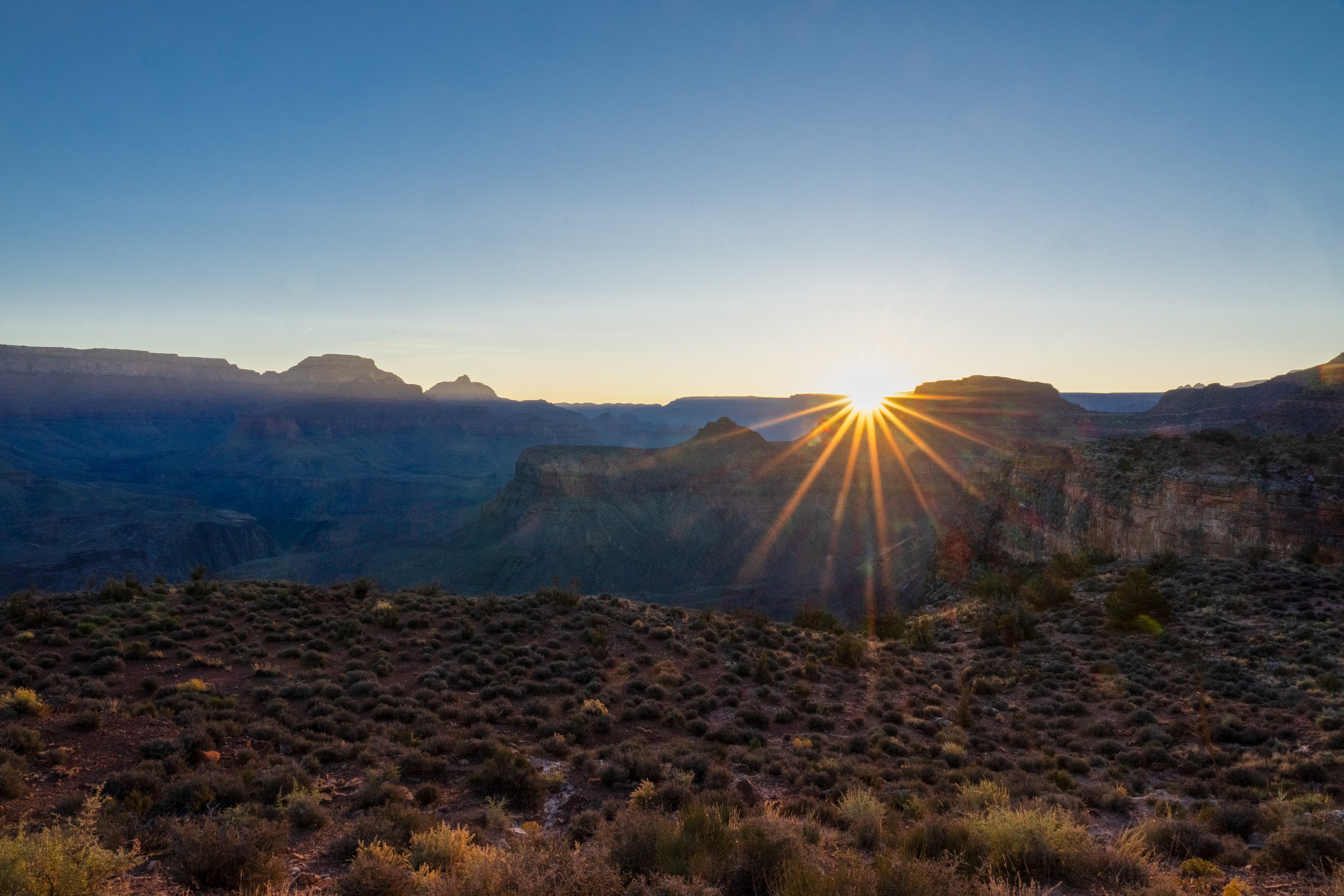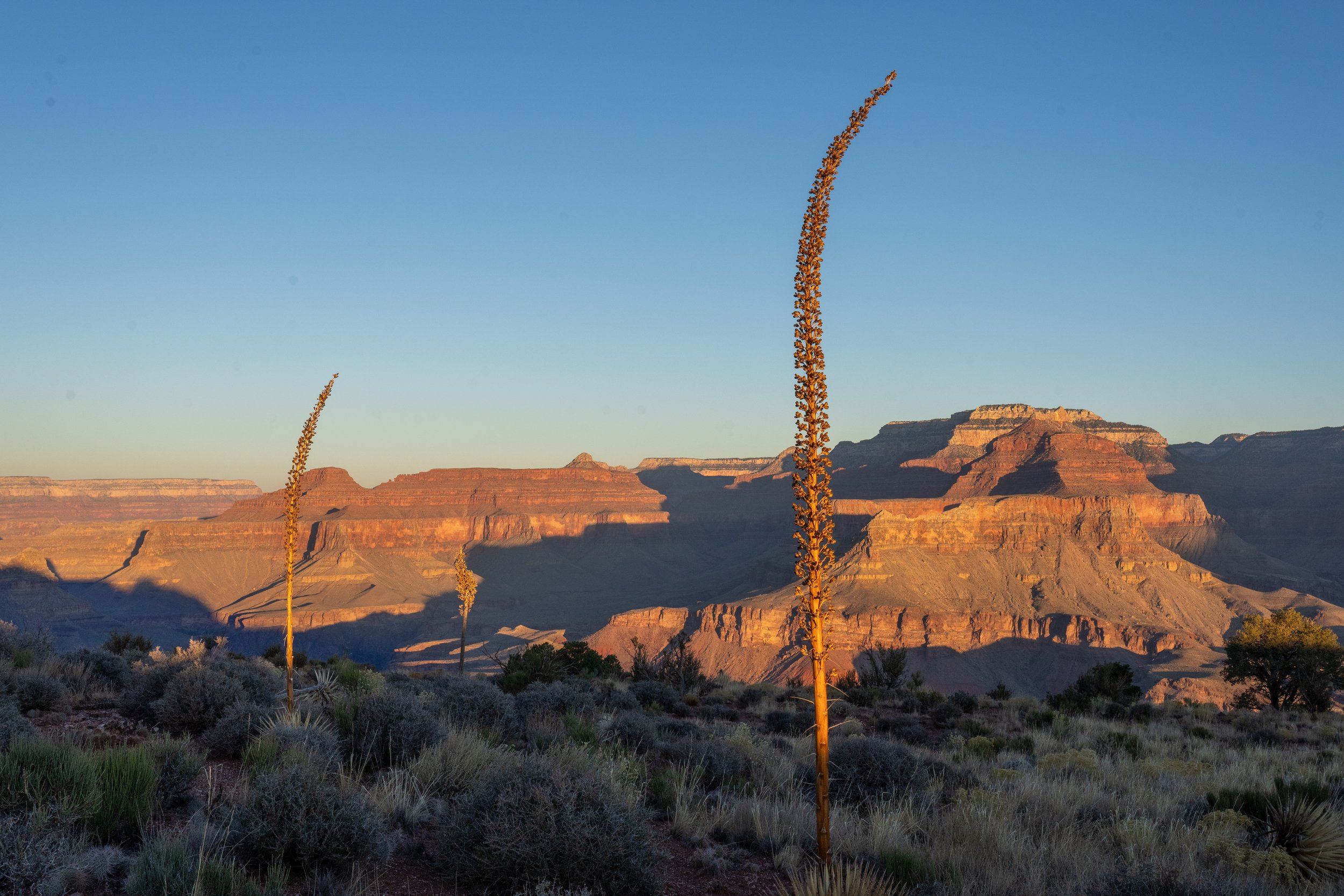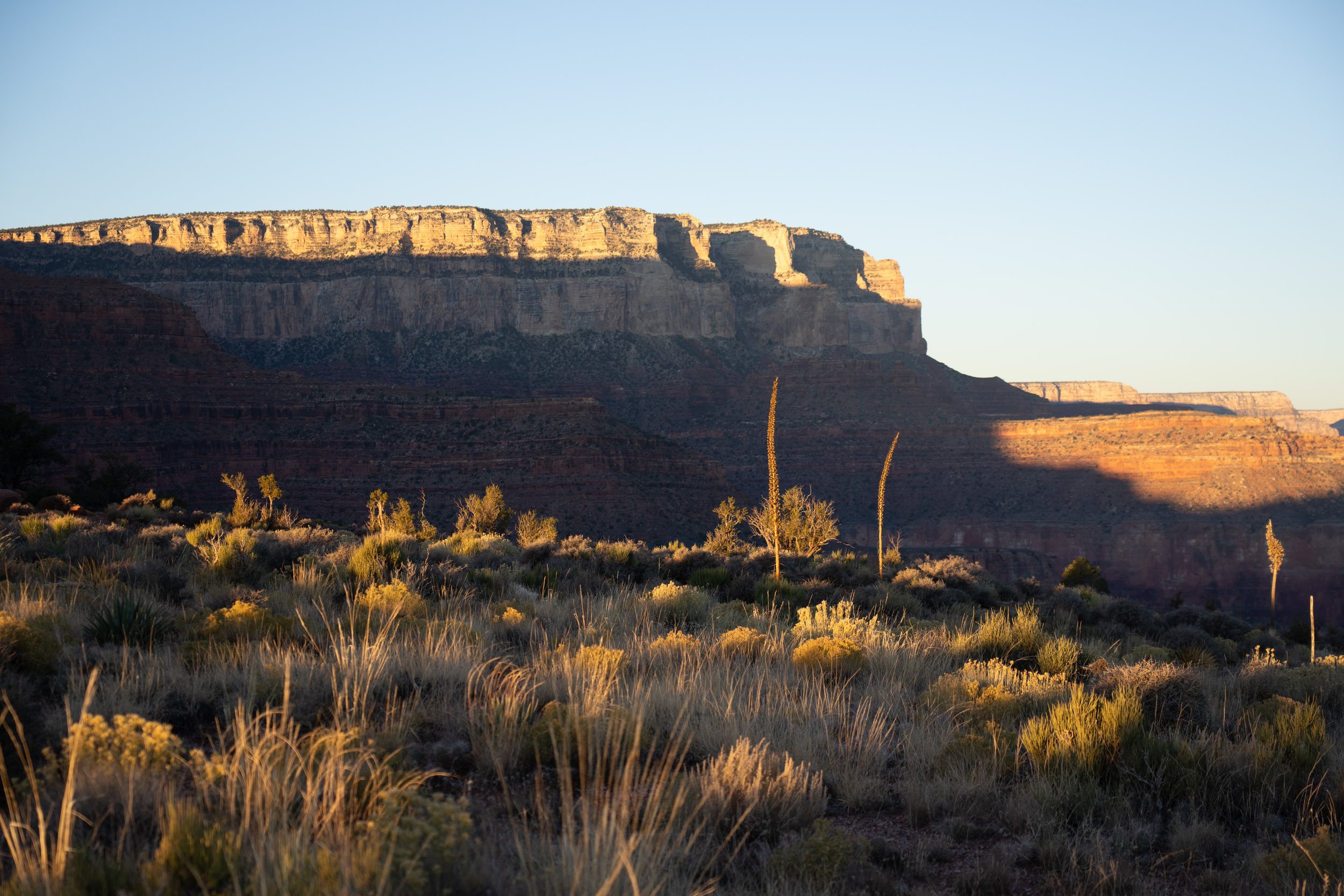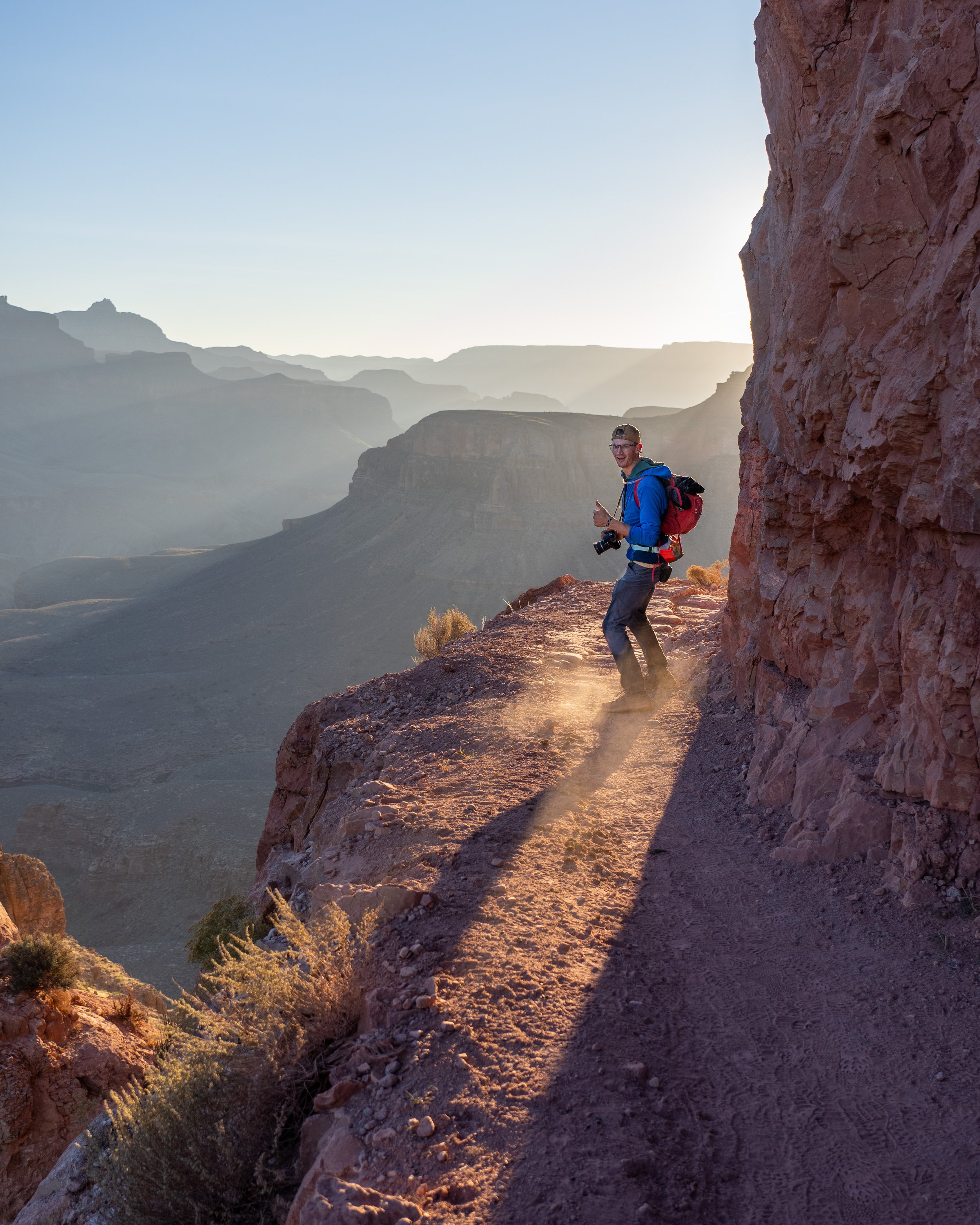A Walk In The Park
Big park, long way down
A Cause for Celebration
(I recommend you view this on a desktop or tablet device.)
5:30. The big dipper lights the way.
There were just a few cars parked along the roadside over at Pipe Creek Vista, the closest starting point for the South Kaibab trailhead further out towards Yaki Point, unless you wanted to wait for the first hiker’s shuttle at 7. It was 5:30. Above, the night sky was alight with stars, and the Big Dipper hung in the middle. I turned off my headlamp. The stars and a crescent moon illuminated the path that skirts the rim. To my left, wafts of cool air floated up out of the quiet darkness of the canyon. Around another turn, I met a dragon’s breath of warm air. The canyon was inhaling and exhaling slowly, preparing for another day.
It was then I realized that I had forgotten my eyeglasses. I knew exactly where they were: sitting back on the car dashboard onto which I had flicked them while anxiously making a last-minute layer change: ditch the long-sleeved shirt and replace it with a short-sleeved performance shirt and hooded stretch fleece jogging jacket. Outside was 24℉. I grabbed the glasses and scampered back along the path, a lone human amongst the Colorado pinyon and Utah junipers. The canyon was still there, dark off to the left. A fragrant mixture of pine, sage, acacia, and buckthorn eddied around as the canyon breathed, almost sighing. Above, the big dipper still twinkled at me. Suddenly, I stopped.
“I’m alive!” I shouted, surprising myself. “Alive!” I thrust my hands into the cold air in primal exultation.
Alive is always a good thing. At 68, it’s a cause for celebration. And that’s why I decided to take a long walk in this big park.
Into the Dark
A thousand feet down Kaibab
I felt a twinge of excitement as I arrived at the trailhead. Without so much as a pre-amble, the trail drops abruptly down through a narrow notch in the sheer cliffs from the top of the canyon. It’s like getting on a roller coaster but at the very top. A small crowd of hikers milled about checking gear, visiting the restrooms, and generally procrastinating in the cold air. A couple of children pranced around, free of hiking sticks and gear. I slipped past most of them, anxious to start the descent and distance myself from them. Some of the hikers sensed my move and responded like a spooked herd, bursting past me and disappearing down the first switchback. Below the rim, the path grew dark as the stars were quickly swallowed by the enveloping cliff walls. I switched on my headlamp, paused to gaze down, and saw a chain of headlamps dancing along the trail and across the first ridge. I could hear chatter both above and below me. Surrounded on three sides by the tight cliff ampitheater, everything sounded so close. I could hear the clacking of the runners’ hiking poles and their quiet, reserved comments about the temperature and about preparations. Already, they were conserving energy for the run down and back up the other side. I could also hear the boisterous cries right behind me. “Hello Alexa, start hike now,” and “Stop! Let’s take a picture!” and “Billy, stay close to your dad!” as well as a string of energetic Wooops and Yehawws.
By the time I reached Ooh Ahh Point (yes, that’s the name)- nearly a thousand feet below the rim - the darkness was slowly giving way to subdued shades of colors that began to reveal the sprawling ridges, cliffs, mesas, and sub-canyons that make up the geological cacophony of the big ditch. A group was huddled together at Ooh Ahh, waiting for the sun to pop above the horizon. I continued a few hundred feet and several switchbacks further to another point on the ridge where the trail makes a straight beeline along the knife edge, then, like the lip of a ski jump, disappears between two gnarly trees off the edge of the world. I call it the Stairway to Heaven.
Stairway to Heaven
It was 6:30 a.m. The sun was coming. I could almost hear it. The entire canyon was waiting.
A Splash of Paint
I was a third of the way down the canyon when the first rays hit me. It was like that part in the Wizard of Oz when monotone Kansas suddenly becomes ultra-saturated Oz, where everyone wears spectacles lest the brightness and glory of the Emerald City blind them. Rays streaked out from the sun and splayed across the ridges in a dizzying array of line casts, a moving light show with live-action color mobs chasing the shrinking shadows into darker but smaller recesses, providing a deepening contrast with the slow-motion explosion of yellows, reds, oranges, and blues—a splashing of paint across the canvas of the great canyon.
Once again, all together now, “I am alive!”
Above, I could hear the oohs and ahhs of excited hikers pummeling down towards me. I broke into a jog as the trail traversed the edge of a long ridge out towards Skeleton Point before plummeting in a series of sharp switchbacks down into a second, nested canyon. At the bottom was a plateau speckled with yucca, cactus, and mesquite. It was 8:00, and the sun painted low angles of light across the wild grasses. Suddenly, it felt warm - maybe from the rising sun, maybe from my exertion, and maybe from having descended into a different climate zone - but probably from all of these. I pulled off my hoodie and threaded it through the straps of my knapsack. Pulled off the half-finger trail gloves, finger by finger. Below sat the last rest stop before the bottom, a metal shelter that provided some well-needed shade for the warmer parts of the day and the warmer days of the year. A group of hikers milled about. I took a swig of coffee and continued down into the third canyon.
Lifeline of the West
A mile below the rim
Think of the three canyons as a set of Russian Babushka dolls, each nested within the other, each distinct but related. I had emerged in a coordinated dance with the sun into the open plateau at the bottom of the second canyon. Light splayed everywhere, long shadows moved across the tableau. But the third canyon is so narrow and deep that most of it does not see direct sunlight until mid- or even late-morning. The trail dropped steeply into a world of dark rock, cool shade, and a faint sense of humidity and evaporation escaping past me, like a lost balloon, upward from the river below - the breathing of the great canyon that I had felt at the very top, under the stars.
During the three hours of descent along parched cliffs, rocky escarpments, and crumbling ridges, I had completely forgotten why this canyon exists in the first place: the Colorado. It’s a big river, the Colorado. It drains all of the American West between the Sierra Nevada and the Rio Grande. And somehow, over time, it blasted right through this chunk of high desert. Why didn’t it just go around?
A vertical mile is a long way down, and then, suddenly, the descent stops. The muscles cry out in exhausted thanks but don’t yet have a language for what to do next. As I stumbled across the suspension bridge at the bottom - hikers and mules only - it felt like both legs were asleep and needed some re-education for walking on horizontal ground.
I stopped to observe a flotilla of rafters pass quietly by underneath. It reminded me of several formative summers at the other end of the Colorado - and at the other end of my life - at a camp on a working ranch called Colorado River Ranch. There, I learned how to ride horses and forge the river with a horse by holding onto the back of the saddle as I floated behind. (Did you know that horses can dog paddle?) Rafting was a big part of the camp. And things were a lot simpler in the 60’s. During my second summer there, as an ‘experienced’ rafter and trusted senior camper, I was given the responsibility of camping overnight - solo - with a depot of rafts and equipment that had been dropped off upstream for a day trip the following morning. There I was, fifteen years old, alone and delightfully oblivious, sleeping under the stars, among the rafts and other equipment. I had no idea what I was supposed to do other than shine a flashlight or bark like a dog should other animals or humans approach in the middle of the night. But I slept well.
The school of rafts floated beneath me and tied up at the beach, and its passengers hopped off to find hot food at the Phantom Ranch canteen, a short walk up the canyon's north side. For those who wish to spend more than just a few minutes and a few dollars gnawing on a stale bagel slathered with peanut butter, Phantom Ranch is the place to hang out.
I had stayed at one of the Phantom Ranch cabins in the middle of Covid. An old high school friend and I had gotten together for a “Covid escape" trip to the canyon. I took advantage of a sudden cancellation to take a tiny cabin at Phantom Ranch, while Jeb opted for the round trip. On that night, it was a full moon. The canteen was closed, but you could order and pick up dinner at the window. There we stood, about a dozen like-minded escapees, a mile below civilization, wearing face masks and distancing six feet apart. I walked back to my cabin, opened the steak dinner, popped open a plastic mini-bottle of red wine, and settled in to watch the sunset - or rather, to watch the stars come out. This deep in Middle Earth, it’s difficult to tell when the sun has set other than to watch the sky above darken.
Back to the present. I stopped at the beach for a quick water refill from a spigot, forced down the aforementioned half-bagel with peanut butter, then continued on my way. I was feeling mildly energetic, and wanted to get back up before it got too hot. The trail crossed the river again, followed for about a mile before turning south through a side canyon and up the Bright Angel route back to the top. I paused at this point, listening to the gurgling sounds of the big river, and wondered whether there would be any water left before it reached its delta at the top of the Gulf of California in Mexico. Sometimes it does, sometimes it does not.
Gazing at the top, reflected in the bottom.
The Big Metaphor
Some say climbing a mountain is a metaphor for life, but hiking down into a canyon is more apt. From the start, everything is easily downhill. Gravity takes care of things while the scenery floats by; you only need to observe. Only as you approach the halfway point - the bottom - do you realize that the second half might be a different experience. You may have chosen a different route back up than the one you took down, so there may be a continuance of new experiences. But everything you learned on the way down is different when going back up: you must go slower. You become less attentive to the scenery and more aware of the need to pace yourself. You slow as you ascend until you stop every few steps for breath by the time you reach the top. Pausing to ‘look at the view’ while waiting for your heart to slow back down so that you can continue up and finish. Just finish. Just get to the end.
About halfway up the Bright Angel Trail, there is a lovely shaded oasis called Havasupai Gardens, where a spring surfaces from below with running water and shaded trees. It’s the only place along the 9-mile trail with running water. Most people stop here for refreshment. But here’s where the metaphor kicks in: Havasupai Gardens may be halfway up in distance, but it’s barely a quarter of the way up vertically. This has the effect of telescoping the remaining 4 ½ miles out almost interminably. The further I walked, the steeper it got and the more exhausted I became.
No way but up.
As I trudged upwards and as lethargy set in, it seemed that the closer I got to the top, the more tourists I encountered on their short ‘forays’ down from the top, all completely fresh, skipping along the trail, sipping on sodas, kids screeching, iPhones reaching for the sky in selfie mode, and all of them looking at me and my other round-tripping comrades-in-exhaustion with distasteful concern, as if we were crawling up out of some dark hole. Which, I suppose, is exactly what we were doing.
Still Alive
Emerging from the canyon and into mid-afternoon light, metaphors swirled through the enveloping euphoria: Accomplishment. Rebirth. Thwarting death. Escape from the crypt. Mostly, I felt my heart still beating hard, the exhaustion, the familiar chills coming on, and the complete lack of thirst or hunger as the body adjusts to the end of a long period of continuous exercise.
I was the last to board the crowded bus that shuttles people along the trailheads, parking areas, and lodges. Standing room only. Even the ‘silver seats’ were taken. Nobody offered me a seat. That was a good thing, right? Apparently, I looked healthy and fit? Or was it my disheveled state, my pants and shoes caked in red dust and the inevitable drops of blood from scratching and scraping? A child looked at me and whispered something to her mother, tugging on her sleeve and pointing. I winked back at her. She shrunk back in shyness.
I’ve been crying out ‘I’m alive’ - or some version of that - since I was a child. Life is a constant companion that begins anew every morning. Every morning. As I progress through life, and as age progresses with me - sometimes tagging along, sometimes leading the way - nothing really changes other than a kind of cumulative appreciation for this tiny planet we are on and the brief flash of a moment that we have on it. Don’t expect any revelations. Don’t expect sudden mystical enlightenment about what lies beyond the thin veil. And don’t expect any real wisdom beyond a steady accumulation of sometimes painful learning points. All that’s there, and all that was ever there, is the purity of constant communion with everything and everyone around us.
It’s a wonderful world. Go check it out.
Lagniappe: Planning
Want to hike the Grand Canyon, from top to bottom and back, in a day? That’s 16+ miles plus a mile of vertical in each direction. In the winter, you’ll need crampons at the top because of the snow and ice; in the summer, it can exceed 140℉ at the bottom. Whatever the season, expect a temperature range of at least 50 degrees between top and bottom and sunrise and afternoon. Still interested? Read on. Less interested? Consider overnighting at Phantom Ranch, at the bottom. Cabins, Dorms, and Campsites. They book up a year in advance, but cancellations are frequent, and you can even try the day-of at the travel office inside the Grand Canyon Lodge. If you’re really out of shape, you can take a mule down and back up, but wow, THAT is going to hurt!
How to Train
You’ll need to be in reasonable cardiovascular shape. If you can run a half marathon, you should be good for an 8-hour round-trip if the temperature is below 80 for your entire hike. 10 miles of running, and you’re probably ok for a 10~12 hour round trip. Add two hours for higher temperatures.
Additionally, you’ll need to condition your muscles for uphill and downhill walking on top of the cardio. Do one or more hikes of 3,000 feet vertically wherever you live. If you can’t get outside, build up to 30 flights of stairs - real or stairmasters. This will get your muscles ready for what is about to happen.
Make sure your feet are comfortable in your hiking boots. They should be ultra-light-weight. I saw joggers and hikers wearing normal running shoes, but some extra support does help. Additionally, ensure that you have at least a half to a full size longer than you would on a flat trail. I’m serious. If your toes are anywhere near the front of your boots, you will come back with black toes because (a) your feet will expand during exercise and (b) no matter how tight your boots, your toes will still find a way to pound against the front of the boots. 20,000 times. Think about that.
Typically, marathon runners run in shoes 1~2 size larger than they train in—same deal.
What to Wear
Easy! As little as possible. What I wore, expecting a low of 25 and a high of 80:
Patagonia R1 Fleece soft stretch trail running hoodie
Columbia Silver Ridge lightweight hiking pants with elastic waistband
Keen’s Targhee waterproof hiking shoes
Black Diamond Crag half-finger gloves. Good for warmth and to use your digits for things like iPhone and taking pics. Also, protection of your palms.
REI Vented Trailsmith hat. I couldn’t find mine, so I wore my salt-crusted REI jogging cap. Felt the sun on the back of my neck, though.
What to Bring
Osprey Sportlight15 pack.
This thing is tiny but holds a 3L reservoir, plus it has two outside pockets for water bottles or your coffee. And it sits off your back, so sweat dissipates. I did not use a reservoir, just the two thin water bottles. I could have used a bit more liquid but was able to refill twice.Leki “journey” light collapsible hiking poles. No need to go expensive. These worked great. Don’t go near the canyon without poles, especially at my age.
Small apples. Lots of them. They last much better than bananas and are great slow-burning carbs, and taste better than GU (yuck).
Two half-bagels with peanut butter. It tastes ok but is easy to digest and packs a punch.
Nothing much else. I brought four cookies and two Kind bars, but didn’t touch them.
Camera, duh. I slipped my Sony DSLR into the top, wrapped in a protective sleeve that I pulled out of my Peak Design Everywhere pack (where my camera gear normally lives). Not to geek out, but 24-105 f/4 is the best single lens. I would have liked to have my 14/1.4 for a few shots, but the iPhone wide lens covered it.
A small camera tripod would be good. I forgot mine. Some nice streams to shoot in slow-mo on the way up, plus the river. Darn. Next time.
Mophie “Powerstation” Battery pack. 24 watt fast charge. I like one with two USB-C ports, one for my iPhone and one for my stupid Apple Watch, which gives up after 6 hours like I wanted to.
Sunblock. I didn’t bring any. I probably should have. But very little of the hike was actually exposed due to topography and time of day.














